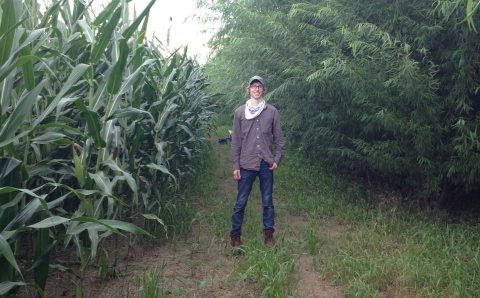A project funded by the Energy Department’s Bioenergy Technologies Office is working to show how perennial plants grown for bioenergy could be integra
Office of Energy Efficiency & Renewable Energy
February 6, 2017When you picture farmland, what is the first thing that comes to mind? Many of us see long rows of crops like corn. However, for many farmers across the United States, this picture is starting to change. Growing deep-rooted perennial crops, like switchgrass or willow, together with annual crops and livestock in a farming system is starting to gain traction. This is due in large part to the potential economic and environmental benefits. For example, deep-rooted plants like these help improve water and soil quality, improve wildlife habitat relative to annual crops, diversify sources of income, and improve overall farm productivity. A project funded by the Energy Department’s Bioenergy Technologies Office is looking to take these benefits one step further, by showing how perennial plants grown for bioenergy could be integrated into agricultural landscapes in a way that benefits the farmer, the larger community, and the environment.
For this project, Argonne National Laboratory (ANL) worked with nonprofit and university partners to measure the environmental benefits of incorporating bioenergy crops into a conventional corn system. At the very heart of this study is a woody crop that once dominated the wicker basket and furniture industry—shrub willow. Although demand for wicker dwindled by the 1930’s, recent interest in the development of bioproducts and bioenergy opened up new markets for shrub willow, revitalizing cultivation of this plant.
Reaching heights of more than 10 feet, shrub willow has many characteristics that make it an ideal crop for sustainable bioenergy production. It is high yielding and fast growing, requires little maintenance, and can be cultivated on marginal or underutilized land—so production can complement, rather than compete with, food or feed crops. These same unique plant traits also provide a range of environmental benefits and ecosystem services. For example, willow’s dense canopy can create habitat for birds and small mammals. Thick root systems also minimize soil erosion and help prevent pollutants and sediments from entering surface and groundwater. Despite the potential, few studies have attempted to measure and quantify the environmental benefits of incorporating shrub willow with traditional corn agriculture. That is where ANL’s study comes in.
The research team examined the potential of willow to act as a buffer to intercept nitrate pollution to support its growth and improve water quality. Nitrogen is a necessary nutrient for plant growth, but it can also pose environmental problems, particularly when heavy rains generate runoff depositing these nutrients in nearby streams, lakes, and groundwater. In addition to impacting human use, excess nitrogen in water can stimulate the growth of aquatic plants and algae, which can reduce the amount of oxygen available for other aquatic organisms. By adding shrub willow buffer strips in a corn field, ANL was able to reduce nitrate concentrations reaching the shallow groundwater by over 30% relative to recorded losses from corn. ANL also determined that willow buffers could be cost competitive with commonly adopted nitrate-management conservation practices. This is a significant achievement that demonstrates how landscape design principles can be used to integrate bioenergy into existing farming systems in a way that improves ecosystem services, while maintaining food and feed production. Watch the short video “Bioenergy in a Multifunctional Landscape” to learn more.


